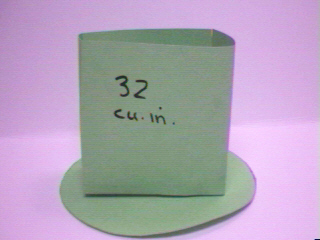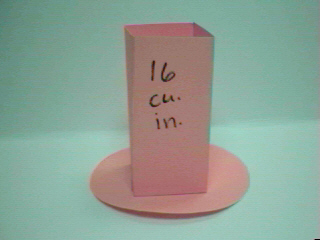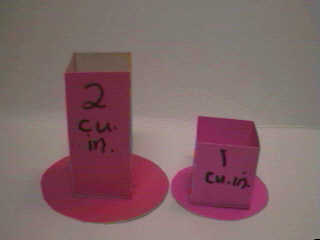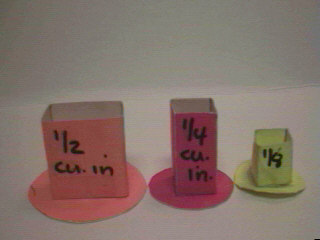Activity
[
Part II: Using the Equipment ]
 Supplies: construction paper or poster
board, scissors, rulers, pencils, tape
Supplies: construction paper or poster
board, scissors, rulers, pencils, tape
Part I.
Making Measuring Equipment
[ top ]
The measuring equipment we are going to make consists of a series of
nine boxes with capacities 1/8, 1/4, 1/2,
1, 2,
4, 8,
16, and 32 cubic inches. Examples are pictured
below. (Click on any image to see it full-sized.)





The boxes are made from poster board and are supported by rather large
circular bases to prevent tipping. Each box must be labeled by its
capacity, for example 1/2 cu. in. (The labels do not have to be
prominently visible. They may even be placed on the bottoms of the
bases.)
Each box is open at the top. It must be constructed very precisely,
fixed with Scotch tape, and firmly glued to its circular base. For
larger boxes, their circular base should be made with a double
thickness of poster board to prevent bending. It is advisable to have
two such sets in a classroom.
Dimensions of Boxes
| Capacity: |
Height: |
Length: |
Width: |
Base Diameter: |
| cubic inches |
inches |
inches |
inches |
inches |
| 1/8 |
1/2 |
1/2 |
1/2 |
7/8 |
| 1/4 |
1 |
1/2 |
1/2 |
1 1/4 |
| 1/2 |
1 |
1 |
1/2 |
1 1/2 |
| 1 |
1 |
1 |
1 |
1 3/4 |
| 2 |
2 |
1 |
1 |
2 7/16 |
| 4 |
2 |
2 |
1 |
3 |
| 8 |
2 |
2 |
2 |
3 7/16 |
| 16 |
4 |
2 |
2 |
4 7/8 |
| 32 |
4 |
4 |
2 |
6 |
Remarks:
To have boxes with narrow openings is preferable, because the
error of measurement is smaller for smaller openings.
The diameter of the circular base was chosen to be equal to the
longest diagonal of the box.
Making the boxes should be a classroom project. The class may be
divided into 9 teams. Each team is responsible for drawing a plan,
cutting out, assembling, and labeling, for two boxes of different
sizes.
The boxes are named by their capacity, so you may say, "Hand me the
one fourths."
The (theoretical) accuracy is 1/16 of a cubic inch (half of the
smallest unit).
The actual accuracy is of course much worse, because the boxes
cannot be filled exactly.
And finally, any amount between 0 and 64 cubic inches can be fitted
with such accuracy in a properly chosen combination of containers from
one set. (This gives 2^9 = 512 different values.)
Examples:
1. Plan for a box of capacity 1/2
(without circular base):
 2. Combinations of boxes giving a given capacity, rounded to the
nearest 1/8 of a cubic inch:
2. Combinations of boxes giving a given capacity, rounded to the
nearest 1/8 of a cubic inch:
| Weight: |
32 |
16 |
8 |
4 |
2 |
1 |
1/2 |
1/4 |
1/8 |
| 45 1/2 |
x |
|
x |
x |
|
x |
x |
|
|
| 18 1/4 |
|
x |
|
|
x |
|
|
x |
|
| 3 5/8 |
|
|
|
|
x |
x |
x |
|
x |
|
Remark:
If you are familiar with base 2, you should notice that the boxes
used, and those omitted, correspond to 1's and 0's in the capacity
written in base 2:
45 1/2 = 101101.1
18 1/4 = 10010.01
3 5/8 = 11.101
Part II.
Using the Equipment
[ top ]
The best material to use is probably rice. Its grains are small, but
not too small to be picked up one by one, and they do not roll when
spilled.
1. Learning how to measure.
Children have to learn how to fill a box to the top, without a
heap, and without trying to pack it down, which can cause the sides of
the container to bulge. (Boxes made of paper instead of stiff poster
board are mostly useless.)
They have to learn to ESTIMATE which container to fill first and
which one to use for the remaining grain.
Remark:
To teach these skills, each amount of rice should be measured twice,
by two children, or by two teams, (preferably with two sets of boxes)
to detect any systematic errors a child might have made in
measurements.
The basic procedure for measuring the capacity of a jar is:
a) Fill the jar with rice.
b) Distribute the rice among the containers in such a way that
All containers except the smallest one used are filled EXACTLY.
The smallest one is more than HALF full. (You must make an
exception for 1/8.)
2. Recording the results.
After filling the boxes, children should compute the total
mentally. (Calculators may be used on a limited basis, or in
exceptional situations. Paper and pencil calculations should not be
used.)
Example:
Boxes 4, 2, 1, 1/2, and 1/8 are filled.
| Say: |
|
Write: |
| Four, six, seven, four eight, five eight |
|
7 5/8 cu. in. |
|
Important remark: Writing units (cu. in.) is
OBLIGATORY.
Calculators may be used for converting between common and decimal
fractions:
[5]
[/]
[8]
[+]
[7]
[=]
7.625 (7.6 cubic inches).
3. Tasks.
A large number of tasks must be used because measuring is a practical
skill that must be practiced.
Examples:
Collect a large number of cups and jars; measure their capacities,
attach appropriate labels and display the collection.
Measure the capacities of different sized spoons (heaped and flat).
|
4. Classroom organization.
It is important that ALL CHILDREN have a considerable amount of
PRACTICE. With the limited number of sets of measuring equipment this
presents considerable difficulty. We do not suggest any solution, but
we point out that having the teacher demonstrate, or having the
children work in large groups where some children do the task and
others only watch are NOT acceptable substitutes for individual
practice.
|





